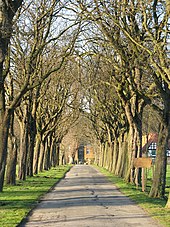Hollwinkel Castle
The Hollwinkel Castle is an end of the 13th century built the castle in the village of Hedem the city Preußisch Oldendorf in East Westphalia Minden-Lübbecke . It stands south of the Mittelland Canal in the Alsweder lowland.
history
It is believed that Hollwinkel Castle was founded at the end of the 13th century by a Holle family who had been expelled from the Hildesheim region. Bishop Otto I. von Minden is said to have awarded the castle as a feudal business. It had been owned by the von Schloen family from around the beginning of the 15th century . Gehle . Hollwinkel was besieged and shot at in 1459 as the western outpost of the Minden diocese in a feud with Osnabrück . However, attempts to take the facility, which was then secured by three forts, failed. Stone balls from this feud were found in the moat in 1871 .
In the Thirty Years' War Hollwinkel was besieged by the Swedes. Hollwinkel withstood the siege. Ultimately, the Swedes moved to neighboring Ellerburg.
The diocese of Minden was secularized in 1648 and then belonged to Brandenburg-Prussia as the Principality of Minden.
After the von Gehle family died out in 1758, the castle fell to the feudal lord Friedrich II of Prussia . In 1758 he transferred it to Baron von Asseburg for 50,000 thalers, who, with the consent of the king, sold it to the Prussian Minister of State Freiherr von der Horst from Haldem for 70,000 thalers in 1776 . After the estate was uninhabited from 1791 to 1830, it has been the main residence of the von der Horst family since the sale of the former Schloss Haldem headquarters .
Hollwinkel manor district
Around 1856, an estate district of Hollwinkel, which was treated as a parish, was newly formed by hiving off the parish of Alswede . On October 1, 1928, it was dissolved and incorporated into what was then the municipality of Hedem.
Building and park
The building was fundamentally rebuilt in 1504. Further construction work followed in the next centuries. The four-wing complex therefore consists of elements from different architectural epochs. The last major renovations took place in the years 1870 to 1873.
After the end of the Second World War, refugee families were quartered on the 2,000 m² living space.
The Mittelland Canal runs 100 m north of the old park boundary. When the canal was built, the hereditary burial was separated from the park. The water structure of the facility, which was designed as a moated castle, was changed after the Second World War. The Große Aue was relocated and now flows west of the castle. The castle can be reached via a 200 meter long chestnut avenue. Before you reach the actual fenced-in castle, you first pass some buildings in front of it, for example half-timbered houses.
Todays use
Apartments and offices are set up in the castle. Since 2011 the Freiherr von der Horst family has been running the Hollwinkel quiet forest, where urn burials are offered under trees. The forest has been part of Hollwinkel Castle for over 200 years. Hollwinkel Castle still includes 80 hectares of forest and 90 hectares of arable land.
See also
literature
- Heinz Bartocha: Hollwinkel Castle in Prussian Oldendorf . In: Palaces, castles, mansions in East Westphalia-Lippe. Westfalen-Verlag, Bielefeld 1986, ISBN 3-88918-038-8 , pp. 199-201.
Web links
- Entry on Schloss Hollwinkel in the scientific database " EBIDAT " of the European Castle Institute
- Landschaftsverband Westfalen-Lippe: Gutspark Hollwinkel in LWL geodata culture
Individual evidence
- ↑ Stephanie Reekers: The regional development of the districts and communities of Westphalia 1817-1967 . Aschendorff, Münster Westfalen 1977, ISBN 3-402-05875-8 , p. 247 .
- ↑ http://www.hollwinkel-ruhewald.de/
Coordinates: 52 ° 20 ′ 30 ″ N , 8 ° 32 ′ 44 ″ E



